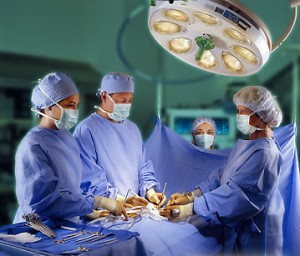 Organ transplant recipients in the United States have a high risk of developing 32 different types of cancer, according to a new study of transplant recipients which fully describes the range of malignancies that occur. Researchers from the National Cancer Institute (NCI), part of the National Institutes of Health, the Health Resources and Services Administration, and their colleagues evaluated medical data from more than 175,700 transplant recipients, accounting for about 40 percent of all organ transplant recipients in the country. The results of this study appeared in the Nov. 2, 2011, issue of the Journal of the American Medical Association.
Organ transplant recipients in the United States have a high risk of developing 32 different types of cancer, according to a new study of transplant recipients which fully describes the range of malignancies that occur. Researchers from the National Cancer Institute (NCI), part of the National Institutes of Health, the Health Resources and Services Administration, and their colleagues evaluated medical data from more than 175,700 transplant recipients, accounting for about 40 percent of all organ transplant recipients in the country. The results of this study appeared in the Nov. 2, 2011, issue of the Journal of the American Medical Association.
In 2010, a total of 28,664 organ transplants were performed in the U.S., including 16,899 kidney, 6,291 liver, 2,333 heart, and 1,770 lung transplants.
“While transplantation is a life-saving therapy for patients with end-stage organ disease, it also puts recipients at an increased risk for developing cancer, in part because of medications administered to suppress the immune system and prevent rejection of the organ. The cancer risk among transplant recipients resembles that of people with HIV infection, whose risk is elevated for infection-related cancers due to immunosuppression,” said lead author Eric A. Engels, M.D., in the Infections and Immunoepidemiology Branch, Division of Cancer Epidemiology and Genetics, NCI. “A clearer understanding of the pattern of cancer risk associated with solid organ transplantation may help future patients have better, healthier outcomes.”
It has been well documented that transplant recipients are at a higher risk for developing cancer than the general population. But past studies of cancer risk in transplant recipients focused mainly on those who received kidney transplants, and other studies were too small to accurately estimate risk for all but the most common cancer types. The large size of this study and the inclusion of recipients of all solid organ types allowed the researchers to provide more accurate estimates of risk for both common and rarer cancers in a representative sample of the U.S. transplant population.
Engels and his colleagues linked data from the U.S. registry of transplant recipients (from 1987 through 2008) with 13 U.S. state or regional cancer registries. They observed a twofold overall increased risk of cancer among all U.S. transplant recipients, which is similar to results from past studies. The researchers also noted elevated risk for 32 different types of cancer, some known to be related to infectious agents (e.g., anal cancer, Kaposi sarcoma) and others unrelated to infections (e.g., melanoma, thyroid cancer).
The researchers also found that the most common cancers among transplant recipients were non-Hodgkin lymphoma (14.1 percent of all cancers in transplant recipients), lung cancer (12.6 percent), liver cancer (8.7 percent), and kidney cancer (7.1 percent). The authors carried out additional analyses of these four cancers and, based on known risk and their new study, report:
Non-Hodgkin lymphoma is elevated more than sevenfold in transplant recipients, with non-Hodgkin lymphoma incidence highest among those who received transplants as children or older adults. This cancer is known to be related to immune suppression and infection with Epstein-Barr virus. Non-Hodgkin lymphoma incidence was highest in lung recipients, intermediate in liver and heart recipients, and lowest in kidney recipients.
Lung cancer risk was highest in lung recipients, with smoking-related disease often the reason for the transplant. Studies of cancer show that among lung recipients, most of whom received a single lung transplant, lung cancer typically arises in the recipient’s remaining diseased lung rather than the transplanted one. Increased risk for lung cancer may also be related to inflammation or chronic lung infections.
The risk of liver cancer was elevated only among liver recipients. Studies of cancer show, in this group, the occurrence of liver cancer can be partly attributed to recurrent hepatitis B or C infection in the transplanted liver, or to diabetes mellitus, which is also common among transplant recipients.
Risk of kidney cancer is increased for all recipients. There are multiple reasons for an elevated risk of kidney cancer in transplant recipients. Recipients who get kidney transplants have damaged kidneys, frequently including multiple kidney cysts, which can become cancerous. However, an elevated risk was also observed among recipients of other organs. Therefore, the researchers suggest the risk for kidney cancer could be partly due to exposure to immune-suppressive medications, which may have direct carcinogenic effects.
“Future work from our group will focus on specific cancers that occur at higher rates among solid organ transplant recipients,” said Engels. “We wish to understand how medical conditions and individual immunosuppressive medications may contribute to cancer risk. In addition, we hope our findings will stimulate other research into the carcinogenic mechanisms associated with organ transplantation.”
# # #
Reference: EA Engels et al. Spectrum of Cancer Risk among U.S. Solid Organ Transplant Recipients: The Transplant Cancer Match Study. JAMA, Nov. 2, 2011.
No Comments Yet